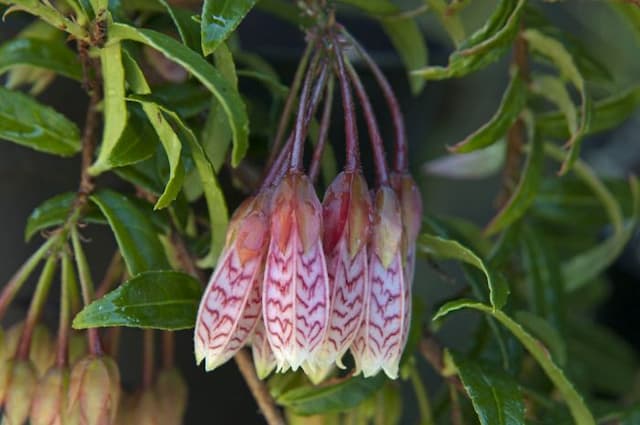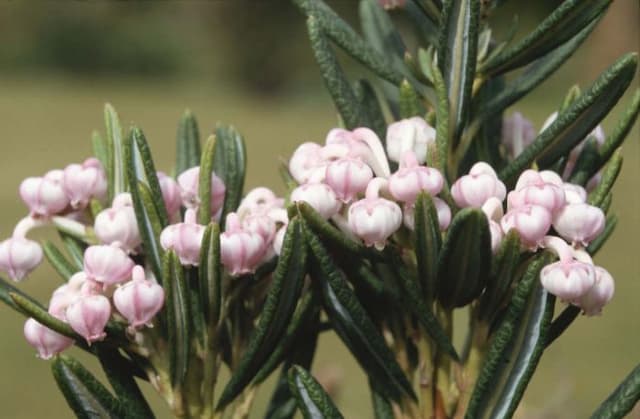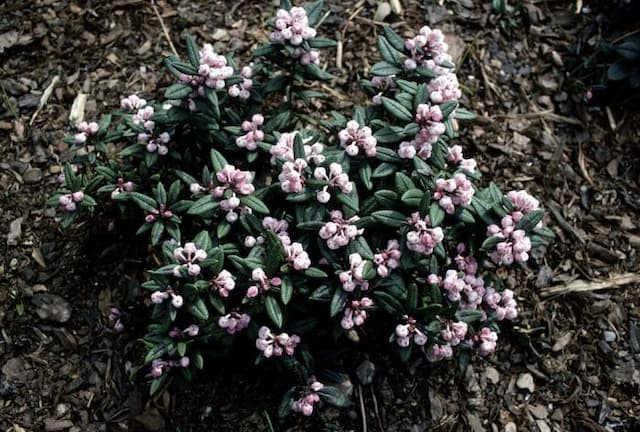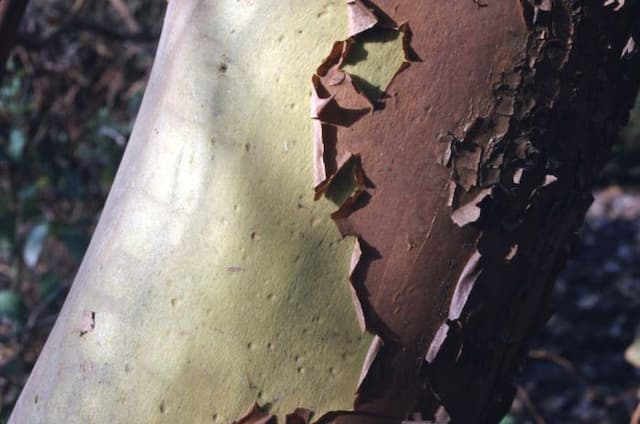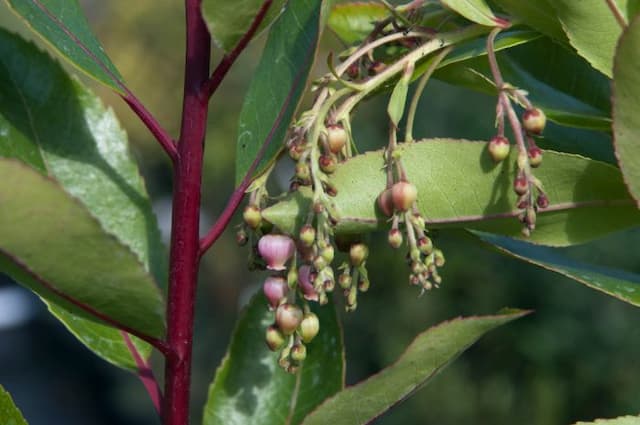Large-leaf Rhododendron Rhododendron macabeanum

ABOUT
Rhododendron macabeanum, commonly known as the large-leafed rhododendron, is a striking ornamental plant known for its impressive foliage and showy flowers. The dark green leaves of this rhododendron are thick and leathery with a glossy texture, and they can be quite substantial in size. The underside of the leaves frequently bears a lighter, fawn-colored indumentum, which is a layer of soft, fuzzy hairs that can add to the leaves' visual interest. This rhododendron variety is celebrated for its spectacular floral display. The flowers emerge in rounded clusters called trusses, each comprising several individual bell-shaped blossoms. These flowers can vary in color, typically showcasing shades of pale yellow to deep gold, and they often exhibit a deeper colored throat with spotting or blotching, which adds depth and contrast to the inflorescence. The large-leafed rhododendron's blooming period is an impressive spectacle when the plant becomes a focal point in the garden due to its abundant and vibrant flowers. The overall appearance of the plant is lush and elegant, making it a highly desirable species for garden enthusiasts who wish to make a bold statement with their plant choices.
About this plant
 Names
NamesFamily
Ericaceae
Synonyms
Large-leaf Rhododendron, Macabeanum Rhododendron, Great Rhododendron
Common names
Rhododendron macabeanum
 Toxicity
ToxicityTo humans
The plant known as the Rhododendron is toxic to humans if any part of it is ingested. It contains grayanotoxins, which can affect the body's sodium channels and lead to poisoning. Symptoms of rhododendron poisoning may include nausea, vomiting, drooling, diarrhea, hallucinations, seizures, and a drop in blood pressure. Severe poisoning could result in coma or death. It's important to avoid consuming any part of this plant.
To pets
Rhododendron is also toxic to pets, such as dogs and cats. It contains grayanotoxins that can cause a range of symptoms if ingested by your pet. These symptoms include vomiting, diarrhea, drooling, weakness, and potentially life-threatening changes in heart rate and blood pressure. Severe cases of rhododendron poisoning can lead to coma or even death. It is critical to prevent pets from ingesting any part of the plant.
 Characteristics
CharacteristicsLife cycle
Perennials
Foliage type
Evergreen
Color of leaves
Green
Flower color
Yellow
Height
10-20 feet [3-6 meters]
Spread
8-15 feet [2.4-4.5 meters]
Plant type
Shrub
Hardiness zones
7
Native area
Himalayas
Benefits
 General Benefits
General Benefits- Ornamental Value: Rhododendron macabeanum, commonly known as the Large-leafed Rhododendron, adds aesthetic appeal to gardens and landscapes due to its large, attractive foliage and beautiful, showy flowers.
- Habitat for Wildlife: The shrub provides shelter and nesting sites for various bird species and other wildlife.
- Pollinator Attraction: The flowers of the Large-leafed Rhododendron attract pollinators such as bees, which is beneficial for the pollination of nearby plants and the overall health of the ecosystem.
- Erosion Control: As a large and robust shrub, the Large-leafed Rhododendron can help prevent soil erosion on slopes and in areas with loose soil.
- Shade Provider: The plant's larger size and dense foliage offer shade and can help reduce local temperature through evapotranspiration, contributing to a cooler microclimate.
 Medical Properties
Medical PropertiesThis plant is not used for medical purposes.
 Air-purifying Qualities
Air-purifying QualitiesThis plant is not specifically known for air purifying qualities.
 Other Uses
Other Uses- Ornamental Display: The large-leaved Rhododendron is often used in landscaping for its impressive foliage and stunning flowers, making it a popular choice for botanical gardens and parks.
- Bonsai: Some enthusiasts use Rhododendron for bonsai due to its attractive flowers and the ability to train its branches.
- Shelter for Wildlife: Birds and small mammals use the dense foliage of the large-leaved Rhododendron for cover and nesting sites.
- Photography Backdrop: The striking appearance of the large-leaved Rhododendron's blooms offers a beautiful background for outdoor photography, particularly in spring.
- Honey Production: Although not a primary source, bees can collect nectar from Rhododendron flowers, which contributes to the production of honey with distinctive flavors.
- Erosion Control: The root system of the large-leaved Rhododendron can help stabilize soil on slopes, thus preventing soil erosion in hilly areas.
- Privacy Screens: Due to their size and dense growth, large-leaved Rhododendrons are planted as natural privacy screens in residential and public areas.
- Cultural Symbolism: The Rhododendron is often associated with cultural significance and symbolism in various regions, used in festivals and celebrations.
- Study of Plant Adaptation: Researchers study the large-leaved Rhododendron to understand how plants adapt to different environments, since it thrives in specific mountainous regions.
- Artistic Inspiration: The vibrant flowers and lush greenery of Rhododendron serve as inspiration for artists, whether in painting, sculpture, or other visual arts.
Interesting Facts
 Feng Shui
Feng ShuiThe Rhododendron is not used in Feng Shui practice.
 Zodiac Sign Compitability
Zodiac Sign CompitabilityThe Rhododendron is not used in astrology practice.
 Plant Symbolism
Plant Symbolism- Beware: Rhododendron plants in general, including Rhododendron macabeanum which is commonly known as Big-Leaf Rhododendron, often symbolize caution due to their toxic properties. Historically, they have been used to communicate a warning or to tread carefully.
- Elegance: Big-Leaf Rhododendron's large, showy flowers and glossy leaves can represent elegance and sophistication in the plant world, making it a symbol of refined beauty.
- Abundance: With its large leaves and prominent blooms, the Big-Leaf Rhododendron can symbolize abundance and wealth.
- Survival: As Rhododendrons are hardy and can grow in challenging climates, they may represent endurance and the ability to overcome adversity.
- Homecoming: In some cultures, Rhododendron is a symbol of homecoming or returning home, as it is often found growing abundantly in specific regions where people identify with it.
 Water
WaterLarge-Leaf Rhododendrons like Rhododendron macabeanum should be watered deeply and infrequently, depending on soil moisture and weather conditions. Generally, watering once a week with 1 to 1.5 gallons of water per plant during active growth in spring and summer is adequate. In hotter or drier periods, increase the amount slightly but ensure the soil drains well to prevent waterlogging. During the fall and winter, reduce watering but do not allow the soil to dry out completely. Always check the soil moisture before watering—a simple touch test with your finger can help assess if the top inch of soil is dry and the plant requires water.
 Light
LightLarge-Leaf Rhododendrons prefer bright, indirect sunlight or partial shade. They thrive under the dappled light of a pine tree or in a location that gets morning sun and afternoon shade, which helps protect the leaves from harsh midday sun. Avoiding direct, hot sunlight is essential to prevent leaf scorch.
 Temperature
TemperatureLarge-Leaf Rhododendron can survive in a temperature range of 20°F to 80°F, but they thrive best in a moderate climate with temperatures between 60°F and 70°F. They are sensitive to extreme heat and frost, so providing some protection during the hottest part of summer and coldest part of winter may be necessary.
 Pruning
PruningPrune Large-Leaf Rhododendron immediately after flowering to maintain shape and encourage bushier growth. Deadhead spent flowers, and cut back the branches selectively to improve air circulation. Pruning once a year is typically enough, and the best time for pruning is late spring or early summer, shortly after the blooming period has ended.
 Cleaning
CleaningAs needed
 Soil
SoilLarge-Leafed Rhododendron requires acidic soil with a pH of 4.5-6.0 for optimal growth. The best soil mix can be composed of 50% peat moss, 30% pine bark, and 20% perlite or coarse sand, promoting good drainage and aeration while retaining sufficient moisture.
 Repotting
RepottingLarge-Leafed Rhododendron should typically be repotted every 2 to 3 years, preferably in the spring before new growth begins. Choose a well-draining acidic soil mix during repotting.
 Humidity & Misting
Humidity & MistingLarge-Leafed Rhododendron thrives in high humidity conditions, ideally between 60% and 80%. It may require additional humidity in dry indoor environments.
 Suitable locations
Suitable locationsIndoor
Place in filtered light, keep soil moist, and maintain high humidity.
Outdoor
Plant in partial shade, mulch well, and shelter from strong winds.
Hardiness zone
9-11 USDA
 Life cycle
Life cycleRhododendron macabeanum, commonly known as the Macabean rhododendron, begins its life cycle with seed germination, which requires a moist and well-drained substrate. Once the seedlings emerge, they develop into juvenile plants, growing leaves and establishing a root system. As they mature, they enter the vegetative stage, during which they focus on foliage growth and develop the characteristic large, leathery leaves. The next stage is the reproductive phase, where the plant produces large, bell-shaped flowers in clusters, typically blooming in late spring or early summer. After pollination, often by insects, the plant develops seed capsules which, upon maturity, open to disperse seeds, completing the cycle. Throughout its life, the Macabean rhododendron requires a cool, temperate climate with acidic soil conditions to thrive and reach its growth stages sucessfully.
 Propogation
PropogationPropogation time
Spring-Early Summer
Rhododendron macabeanum, commonly known as the Big-leaf Rhododendron, is typically propagated by semi-hardwood cuttings. This method is most successfully carried out in late summer, allowing sufficient time for the cuttings to form roots before the onset of cold weather. Cut a 4 to 6 inch (about 10 to 15 cm) length of stem with several leaves attached from a healthy parent plant. Ensure that the cutting includes a small portion of the previous year's wood, known as a "heel". Dip the cut end in rooting hormone to encourage root development, and insert the cutting into a mixture of peat and perlite or a similar well-draining rooting medium. Maintain high humidity and a steady temperature of about 70 to 75 degrees Fahrenheit (21 to 24 degrees Celsius) until roots have formed. The new plants can then be acclimatized to outdoor conditions and eventually planted in their permanent positions.
